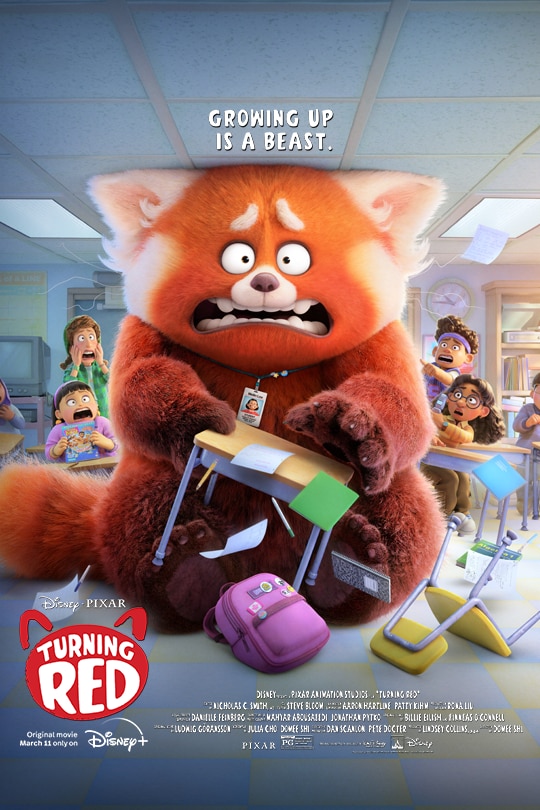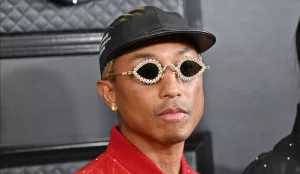We Need to Talk About “Turning Red”
March 28, 2022
Scrolling on social media lately, you might have noticed a new surge of popularity for Disney Pixar’s latest movie release, Turning Red. The new movie has been gaining lots of attention lately for its themes, messages, animation style, and soundtrack.
“But what’s the big deal? It’s just another Disney movie; they always do well. Why’s this one any different?”
That’s what I was thinking when I first saw it get popular, too. I’m quick to be a skeptic, always wondering why random children’s movies continue to make their way into mainstream media, but I finally sat down and watched it the other day, and I can tell you I was far from disappointed. I can say with a fair amount of certainty that Turning Red might be Pixar’s best work in a very, very long time. Maybe even since Inside Out.
I was beyond impressed with this movie. It boldly tackled issues I’ve not yet even seen discussed in a kid’s film, and did so with accuracy and grace. It really blew me away.
The movie is about a Chinese-Canadian family living in Toronto in 2002. The main character, 13-year-old Meilin “Mei” Lee, is just like any other girl her age. She studies, goes to school, hangs out with her friends, and most importantly, she helps out her family, especially her mother, at the temple they run. At the beginning of the movie, Mei chiefly honors her family, even if it gets in the way of her social life.
Right off the bat, it’s relatable, and culturally appreciative. Of course, I am not of Chinese descent, so I’m not one to speak on how Chinese viewers reacted to the movie, but it seems to me that director Domee Shi sought to kill two birds with one stone, by accurately depicting the culture and the people within it, while finding a way that all viewers could appreciate, understand, and even relate to the aspect of wanting your parent’s approval, by honoring and respecting them first. I know I learned a lot that I didn’t know before, and I’m very grateful to the movie’s team for that. Many see it as a big win for people of color, especially women and girls.
In fact, this is Pixar’s first film directed only by a woman. You might know Domee Shi, because she was the mind behind the short film, Bao (2018) which won the Oscar for best animated short.
Going back to the plot, we learn Mei is at a crossroads. She finds herself changing and wanting to distance herself from her parents, hitting puberty hard, and going boy crazy along with her friends Abby, Miriam, and Priya. One morning after a spat with her mom, Mei wakes up in the form of a giant red panda! Her parents explain that it’s a trait all the women in her family inherit, and that there’s a way to make it go away forever.
But this is what I’d like to analyze for a second. Never, in all my years, have I heard a movie, especially a Disney movie, address a young girl entering puberty without a negative connotation. Never have I heard a Disney movie intelligently, as well as sensitively, addressing such realistic life events as Turning Red did.
I was pleasantly surprised and delighted all at the same time. This movie shows, ever so casually, effortlessly even, that it’s not a bad thing. That it’s not something to keep hush-hush about, that it’s not this scourge that all womankind has to bear in silence, and that it’s perfectly normal and manageable. It’s beautiful, and I think it’s even more delightful that little girls can grow up with a movie like this, normalizing that oh-so awkward phase of life. And no one’s talking about it!
“Turning Red was a movie that had to be made, especially for kids growing up. Going through puberty can be a rough time, but this movie shows that it happens to everyone, and I find that very comforting,” said senior Margaret Coll.
Returning to plot, at first Mei is freaked out by her panda power. She can’t control it and ends up going on a small rampage at her school and around town, until her mom calms her down and assures her of the ritual that will put it away forever. For the time being, Mei realizes that she can control her panda if she thinks of her friends calming her down and reassuring her that it’s going to be ok. I think this is such an adorable depiction of how important it is to have genuine friends in life.
Later, Mei and her friends use Mei’s new panda power to raise money to go see “4town,” the boy band pop group their parents don’t approve of. The band was heavily inspired by real life groups like *NSYNC, the Backstreet Boys, O-Town, and yes, even BTS! Fun fact: Billie Eilish and her brother, FINNEAS, actually created the music sung by the group, with Finneas even voicing one of the members!
During the process of raising money, Mei begins to become more of a rebel. She tells white lies to her parents in order to to help her friends raise money, she skips her temple duty, and she runs off without a second word. The climax of the film comes with Mei’s mother discovering her daughter’s double life, and calling in all her of female extended family members to come take care of the panda. Mei is caught, realizing she’ll have to miss the concert in order to go through with the ritual.
The ritual begins as the concert does, with Mei’s friends sadly attending without her. As the ritual comes to its point of no return, Mei heads for her own. She declines to rid herself of her panda, and runs away to the concert, furry form activated! Infuriated, her mother’s own panda form breaks out after being dormant since she was Mei’s age, and chases her all the way to the concert. The only difference is that Mei’s mother’s panda is about the size of the skyscraper, so naturally the concert came to a screeching halt when she arrived.
The two have the classic mother/daughter fight in so many movies, while still in panda form. The rest of Mei’s family comes rushing over, wanting to put the two pandas away. Mei’s friends, and the members of 4town, stay behind.
In a beautifully scripted argument scene, Mei expresses to her mother that she isn’t like her, that she wants to keep the panda, and that she wants to find her own identity outside of her family life as she matures. Naturally, her mother is hurt, but understanding. Once the pandas are calmed and put away, the two make up with the help of family (and 4town).
So at the end of the movie, Mei keeps her panda, and her relationship with her family. She’s given the freedom to be more openly herself, while also being a daughter her mother can be proud of.
Another student, senior Sam Getchell, reflected on the movie, saying, “TURNING RED WAS SO GOOD! I really loved the dynamic of kids being allowed to be kids with no ‘monumental moment’ in which they have to grow up.”
So overall, Turning Red is a beautiful film, one of the best from Disney in a while. It easily outdoes movies like Tangled, Frozen, Inside Out, and I’d even put it up against Encanto and Soul. It is an enormous accomplishment, and I hope it gets the love it deserves.
Diving boldly and shamelessly into themes like family, culture, female puberty, true friendship, female family dynamics, and familial acceptance, Turning Red is truly a trailblazer for a new era of Disney films. It doesn’t look back, in fact, I think it sets the bar even higher for future children’s movies, ones where girls don’t have to find themselves ashamed for their awkward phases, for rebelling, for being hormonal, for having crushes, for liking different things, and ones where we all collectively kill the parts of us that cringe!

And of course, the movie can be enjoyed by men and those who go by male. In fact, I encourage them to. It’s funny, it’s cute, and most of it is all-encompassing. Its not vulgar, it’s not “too feminist,” nor too over the top. Seriously, there’s no reason a guy can’t enjoy it as well. Its themes are important for men to learn, too. After all, how many movies have women sat through that tell of life through the lens of a man? How much do girls know about male puberty from movies and TV alone, compared to the other way around? Turning Red is the exact opposite of that, beginning a trend of equalization.
The only issue I’ve seen raised about it is parents thinking it is too forward for a children’s audience. It’s true that it is surprising at first glance, even I was taken aback. No movie I grew up with was like this. So for parents, the movies they saw were probably even more cloistered. However, Turning Red teaches truly important lessons to kids who are growing up. Kids shouldn’t be shielded from media that is literally meant for them. So I don’t see the concern as being based on anything but the shock factor. All kids grow up some day. So all in all, I do think it is a perfect movie to be enjoyed by the whole family.
This article doesn’t begin to do this film justice. I can talk about it all day. If you haven’t already, go watch Turning Red, streaming on Disney+ now.















